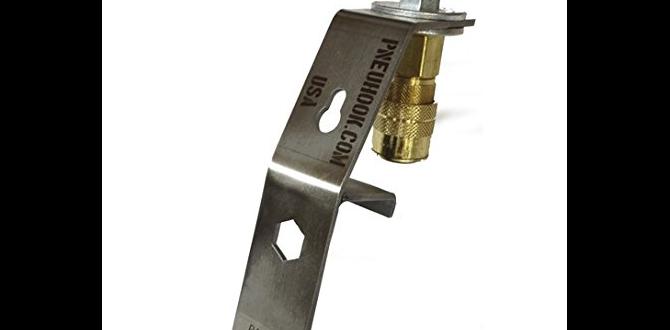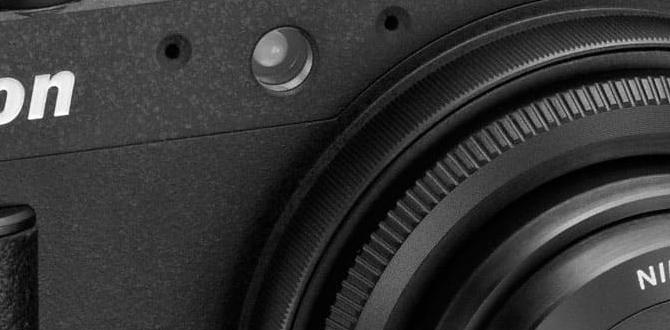Quick Summary:
Choosing the right roofing coil nailer specification, like nail size, magazine capacity, and power source, is key for efficient and safe shingle installation. This guide breaks down essential specs to help you pick the perfect tool for your project, ensuring a durable and professional finish every time you hit a nail.
Hey there, DIY roofing warriors! Jack Shaffer here, your go-to guy for all things nailers at Nailerguy. Ever found yourself staring at a roofing coil nailer, completely baffled by all the technical specs? You’re not alone! It can get confusing, and picking the wrong one can slow you down and even mess up your new roof. But don’t sweat it. We’re going to walk through exactly what those specifications mean and how to choose the perfect roofing coil nailer for your next project. Get ready to feel super confident about your tool choice!
Table of Contents
Why Nailer Specs Matter for Roofing
Nailing down shingles might seem straightforward, but the right tool makes a world of difference. A roofing coil nailer is designed specifically for this job, handling asphalt shingles, felt underlayment, and even some siding tasks. Understanding its specifications ensures you’re not just using a tool, but the right tool.
This isn’t about having the most expensive nailer; it’s about having one that fits your needs. Whether you’re re-shingling your own home or helping out a buddy, knowing what to look for will save you time, frustration, and potentially costly mistakes. Let’s get you armed with the knowledge to make a smart buying decision.
Understanding the Key Roofing Coil Nailer Specifications
When you’re looking at roofing coil nailers, a few key numbers and features will pop up. These aren’t just random details; they directly impact how well the nailer performs for roofing applications. We’ll break them down so you can understand what each one means for you.
1. Nail Size and Type
This is arguably the most critical specification. Roofing coil nailers drive specific types and sizes of nails designed for weather resistance and proper shingle fastening.
- Nail Diameter: Roofing nails are typically stout to prevent pull-through and hold shingles securely. Common diameters range from .113 inches to .131 inches (about 2.87mm to 3.33mm). A thicker shank provides better holding power.
- Nail Length: For standard asphalt shingles, nails usually need to be between 1 inch and 1.5 inches long. This length ensures the nail goes through the shingle and into the roof decking securely, but not so deep that it misses the decking or goes through the other side. Always check your shingle manufacturer’s recommendations for the precise length required.
- Nail Head Type: Roofing nails have broad, flat heads. This large surface area helps prevent the nail head from pulling through the shingle material, which is crucial for keeping shingles in place, especially under wind pressure.
- Nail Collation: Roofing coil nailers use wire-collated nails, meaning the nails are held together in a coil by a thin wire. This allows the magazine to hold a large number of nails, reducing the frequency of reloads. The angle of the collation (how the nails are connected) is important; most roofing coil nailers use either 15-degree or 17-degree collation. Ensure the nails you purchase match your nailer’s collation angle.
Why it matters for DIYers: Using the wrong nail size or type can lead to shingles blowing off in the wind, leaks, or even damage to the nailer itself. Always match your nailer’s capability with the nails specified by your roofing material manufacturer.
2. Power Source
The way a roofing coil nailer is powered affects its performance, portability, and upfront cost. You’ll generally find three main types:
- Pneumatic (Air-Powered): These are the workhorses of the professional roofing world. They require an air compressor and an air hose to operate.
- Pros: Lightweight in hand, powerful drives, durable, generally less expensive per nailer than other types, and they don’t overheat.
- Cons: Requires an air compressor, air hose, and often an air line oiler. The compressor itself is noisy and needs power.
- Cordless (Battery-Powered): These nailers are becoming increasingly popular with DIYers due to their convenience. They use powerful rechargeable batteries.
- Pros: Highly portable (no hoses or compressors needed), quick setup, good for smaller jobs or tight spaces where an air hose would be cumbersome.
- Cons: Heavier in hand due to the battery, can be more expensive upfront, battery life might limit continuous use on very large roofs, and some models might not have the same sheer driving power as pneumatic for very dense decking.
- Gas-Powered: These use a combination of a fuel cell (like propane) and a battery for ignition.
- Pros: Very portable, no hoses or cords, powerful.
- Cons: Can be expensive, require fuel cartridges, exhaust fumes can be a concern in enclosed spaces (though less so on an open roof), and they have a distinct smell.
Why it matters for DIYers: For a one-off shingle project on your home, a cordless model offers the most convenience. If you plan on doing extensive roofing or siding work, or already have a compressor, pneumatic might be the more cost-effective and reliable choice long-term.
3. Magazine Capacity
The magazine is where the nails are loaded. Its capacity determines how many nails the nailer can hold before you need to reload. Roofing coil nailers typically have high magazine capacities.
- Typical Range: Most roofing coil nailers can hold between 90 and 120 nails.
Why it matters for DIYers: A larger capacity means fewer interruptions to reload. On a roof, reloading means climbing down or maneuvering with nails, which takes time and energy. For a large roof, a higher capacity nailer will significantly boost your efficiency. For a small shed roof or repairs, a slightly lower capacity might be acceptable.
4. Firing Mechanism
This dictates how the nailer fires. There are two main types relevant here:
- Contact Actuation (Nailer Fires When Trigger is Pulled AND Nose is Pressed): This is the most common and safest mode for roofing. You press the nose of the nailer against the shingle and decking, then pull the trigger. This “bump” or “contact” firing is fast and efficient for repetitive nailing.
- Sequential Actuation (Nailer Fires ONLY When Trigger is Pulled, but Nose Must be Pressed First): This offers more precise control but is generally slower for roofing applications where speed is beneficial.
Why it matters for DIYers: Contact actuation is usually preferred for roofing tasks. It allows you to quickly set the nailer and fire it rapidly as you move along the roofline, speeding up the job considerably. Safety features of contact actuation often include a safety trigger mechanism that prevents accidental firing when the tool is not pressed against a surface.
5. Weight and Ergonomics
You’ll be holding this tool overhead and at various angles for extended periods. Its weight and how it feels in your hand are crucial.
- Weight: Pneumatic nailers are usually lighter in hand than cordless because the battery and motor are separate. However, you also have to account for the weight of the compressor and hose. Cordless models can range from 4 to 9 pounds.
- Grip: A comfortable, non-slip grip is essential for control, especially when working at heights or in dusty conditions.
- Balance: How the tool is balanced can make a big difference in reducing fatigue.
Why it matters for DIYers: A lighter, well-balanced tool will mean less fatigue at the end of the day. This translates to better accuracy and fewer mistakes. Try to hold a few different models if possible before you buy, or read reviews specifically mentioning ergonomics.
6. Depth Adjustment
This feature allows you to control how deep the nail is driven into the material.
- Importance: Properly seating the nail is vital. Nails should be driven flush with the surface of the shingle, not sunk too deep (which can create a weak spot and potential leak point) and not left proud (which can puncture the shingle above it and create a leak).
- Types of Adjustment: Some nailers have simple dials, while others require a tool (often a hex wrench) to adjust a depth guide or air pressure (for pneumatic). Tool-less adjustment is more convenient for on-the-fly changes.
Why it matters for DIYers: Being able to quickly and easily adjust the nail depth is key. Different shingle materials or roof decking densities might require slight adjustments to ensure each nail is perfectly seated. Look for a nailer with an accessible depth adjustment system.
7. Jam Clearing Mechanism
Nail jams happen. How easy it is to clear them can save you a lot of headaches.
- Tool-Less Clearing: The best systems allow you to clear a jam without needing any extra tools. Typically, this involves opening a latch on the nailer’s nose and removing the jammed nail.
- With Tools: Some older or simpler models might require a hex wrench or screwdriver to open up the nose and clear a jam.
Why it matters for DIYers: When you’re on the roof, fumbling for tools to clear a jam can be frustrating and time-consuming. A tool-less jam clearing mechanism is a huge convenience and will keep your project moving.
Essential Roofing Coil Nailer Specifications Table
Here’s a quick reference table to help you compare different roofing coil nailer specifications:
| Specification | Typical for Roofing | Key Considerations for DIYers | Impact on Performance |
|---|---|---|---|
| Nail Size (Diameter) | .113″ – .131″ | Ensure compatibility with shingle manufacturer specs. | Holding power, prevents pull-through. |
| Nail Size (Length) | 1″ – 1.5″ | Match required length for shingle and decking combination. | Sufficient penetration into decking. |
| Nail Head Type | Broad, flat | Standard for roofing; check for specific needs. | Prevents nail head from tearing through shingles. |
| Nail Collation | Wire, 15° or 17° | Must match nailer’s collation angle. | Magazine loading and feeding reliability. |
| Power Source | Pneumatic, Cordless, Gas | Portability, job size, existing tools (compressor). | Mobility, power, setup time, weight. |
| Magazine Capacity | 90-120 nails | Higher = fewer reloads = more efficiency on large jobs. | Job speed, reduces interruptions. |
| Firing Mechanism | Contact Actuation | Preferred for speed and ease of use on roofs. | Fast, repetitive nailing. |
| Depth Adjustment | Tool-less (preferred) | For precise nail seating to prevent leaks. | Professional finish, prevents shingle damage. |
| Jam Clearing | Tool-less (preferred) | Saves time and frustration on the job. | Minimizes downtime. |
Choosing the Right Nailer for Your Project Size
Not all roofing projects are created equal. The size and scope of your job will heavily influence which nailer specifications are most important.
Small Repairs or Shed Roofs
If you’re patching a few spots or re-shingling a small garden shed, convenience and portability might be your top priorities.
- Cordless models shine here. You don’t need to drag out a compressor for a small job.
- Weight becomes more important if you’re working on a ladder or in tight spots.
- Magazine capacity is less critical, but still a nice-to-have.
- Depth adjustment is always important for a good finish.
Average Home Roof (DIY Project)
For a typical residential roof, you’ll be spending a significant amount of time working. Efficiency and reliability are key.
- Pneumatic nailers are often the best choice if you’re on a budget and have access to a compressor. They are generally more durable for extended use and less expensive per nailer.
- Cordless options are still great if you value the freedom from hoses and hoses, but ensure the battery has enough capacity for the job.
- High magazine capacity becomes a real benefit to keep your workflow going.
- Ergonomics and weight are very important to prevent fatigue over days of work.
Large or Commercial Projects (Less Common for DIY but Good to Know)
For professionals or very ambitious DIYers tackling large surfaces, maximum efficiency and durability are paramount.
- Pneumatic systems are the king here, offering consistent power and speed, with the compressor acting as a reservoir for sustained nailing.
- Durability and reliability are non-negotiable. Professional-grade tools are built to withstand daily use.
- Maintenance features like tool-less jam clearing and easy access for lubrication are highly valued.
Safety First: Essential Safety Tips for Using Your Roofing Coil Nailer
Working on a roof with power tools comes with inherent risks. Always prioritize safety. The Occupational Safety and Health Administration (OSHA) provides excellent resources for construction safety, and many of their principles apply directly to DIY roofing.
Here are some critical safety tips:
- Wear Safety Glasses: Always, always, always wear safety glasses or goggles to protect your eyes from flying debris or recoil. A hard hat is also a good idea.
- Secure Footing: Ensure you have stable footing on the roof. Use scaffolding, safety harnesses, or secure ladders. Never overreach; reposition yourself safely.
- Understand Your Tool: Read the manufacturer’s manual thoroughly. Know how your specific nailer operates, its safety features, and how to clear jams.
- Keep Fingers Away from the Nose: Never point the nailer at yourself or anyone else. Keep your fingers clear of the firing mechanism and the nose of the tool.
- Proper Nail Loading: Ensure nails are loaded correctly according to the manual. A misaligned nail can cause jams or misfires.
- Disable When Not in Use: Disable the tool (disconnect air hose for pneumatic, remove battery for cordless) when not in use, when changing nails, or when walking away from the job.
- Work in Good Conditions: Avoid roofing during rain, high winds, or extreme heat/cold, as these conditions increase risk.
- Tethering: If working at significant heights, consider tethering your nailer to prevent it from falling.
Remember, when in doubt, consult professional guides or your local building codes. For state-specific safety regulations, resources like the OSHA regulations on walking and working surfaces are invaluable for understanding fall protection and safe work practices.
Maintenance for Longevity
To get the most out of your roofing coil nailer and ensure it performs reliably, a little regular maintenance goes a long way.
- Pneumatic Nailers:
- Use air tool oil in the air line daily.
- Drain water from the air compressor tank regularly.
- Check air filters and clean or replace as needed.
- Keep the air inlet and exhaust ports clean.
- Cordless Nailers:
- Keep batteries charged and store them properly.
- Clean the exterior of the tool regularly.
- Ensure the magazine is free of debris.
- Refer to the manual for specific lubrication points or maintenance schedules.
- All Nailers:
- Clear jams promptly and correctly.
- Inspect the nose and firing pin for wear or damage.
- Store the nailer in a clean, dry place when not in use.



